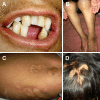Papillon-lefevre syndrome
- PMID: 21886733
- PMCID: PMC3163345
- DOI: 10.3315/jdcr.2009.1039
Papillon-lefevre syndrome
Abstract
Background: Papillon-Lefevre syndrome is a rare autosomal recessive disorder caused by cathepsin C gene mutation leading to the deficiency of cathepsin C enzymatic activity. The disease is characterized by palmoplantar hyperkeratosis, loss of deciduous and permanent teeth and increased susceptibility to infections. Onset of palmoplantar hyperkeratosis and periodontopathy is most commonly before the age of 4 years.
Main observations: A 15 year old boy with a history of frequent infections presented with hyperkeratosis of palms and soles, which worsened during winter season. Examination of the oral cavity revealed missing mandibular central incisors and left lateral incisors. Most remaining permanent teeth were mobile. Fibrosis and scarring of gingival and labial mucosa restricted opening of the mouth.
Conclusion: Early diagnosis of Papillon-Lefevre syndrome may help preserve the teeth. We present a case of a late diagnosis of this syndrome.
Keywords: Papillon-Lefevre syndrome; cathepsin C; gene mutation; hyperkeratosis; infections; keratoderma; oral mucous membranes; psoriasis; teeth.
Figures
References
-
- Dhanrajani PJ. Papillon-Lefevre syndrome: clinical presentation and a brief review. Oral Surg Oral Med Oral Pathol Oral Radiol Endod. 2009;108:e1–7. - PubMed
-
- Ullbro C, Crossner CG, Nederfors T, Alfadley A, Thestrup-Pedersen K. Dermatologic and oral findings in a cohort of 47 patients with Papillon-Lefèvre syndrome. J Am Acad Dermatol. 2003;48:345–351. - PubMed
-
- Meade JL, de Wynter EA, Brett P, Sharif SM, Woods CG, Markham AF, Cook GP. A family with Papillon-Lefevre syndrome reveals a requirement for cathepsin C in granzyme B activation and NK cell cytolytic activity. Blood. 2006;107:3665–3668. - PubMed
Publication types
LinkOut - more resources
Full Text Sources

